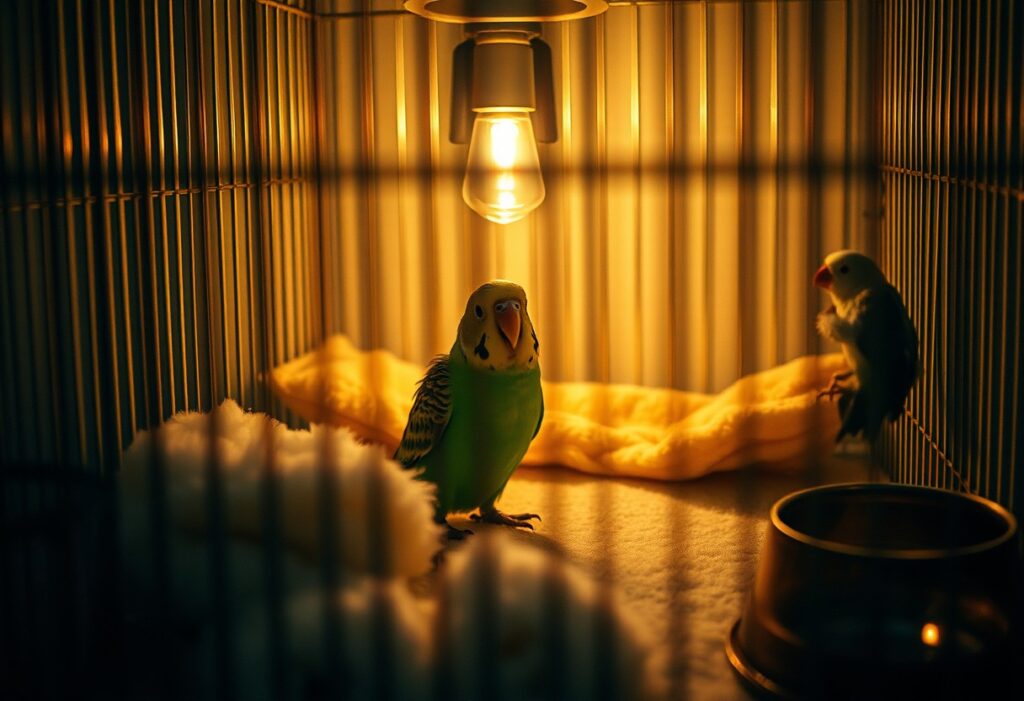There’s a delicate balance to strike when caring for a bird that fears new surroundings. Understanding your bird’s anxiety is crucial, as it can lead to stress and behavioral issues if not addressed properly. In this guide, you’ll learn effective strategies to help your feathered friend adapt to changes in their environment, ensuring their welfare and happiness. By creating a safe space and gradually introducing new elements, you can make the transition smoother and less intimidating for your pet. Let’s explore the steps you can take to help your bird feel secure and confident.

Understanding Your Bird’s Fear
Before you can effectively help your bird cope with new surroundings, it’s crucial to understand the underlying causes of their fear. Birds, like humans, can experience a range of emotions, including anxiety, especially when they are exposed to unfamiliar environments. This understanding will guide you in developing strategies that will ease their discomfort and build their confidence over time.
Common Causes of Anxiety in Birds
One significant factor contributing to your bird’s fear can be unfamiliar environments. When introduced to new spaces, your bird may feel threatened by the unknown, leading to stress and anxiety. Loud noises, unfamiliar pets, sudden movements, or even new people can intensify their apprehensive behavior.
Another common cause of anxiety is related to the lack of socialization. Birds that are not well-socialized during their formative months may be particularly wary of new experiences. If your bird has not been gradually accustomed to different surroundings and stimuli, it may become easily frightened, increasing its likelihood of experiencing anxiety in these situations.
Factors Affecting a Bird’s Comfort Level
Causes of a bird’s fear can vary, but certain factors significantly impact its comfort level within its environment. One of the primary influences is the familiarity of the surroundings. The more accustomed your bird is to its space, the more relaxed it will become. Additionally, the presence of stable routines provides a sense of security that can help lessen anxiety. Birds thrive on consistency, and any changes to their routine can lead to increased fear and distress.
- Familiarity
- Stable routines
- Socialization
This emphasizes the importance of maintaining a consistent environment for your bird whenever possible. Training your bird to adjust to new stimuli gradually helps build its confidence and comfort level. Engaging in positive reinforcement can also be instrumental in easing their fear of new settings.
The additional factors influencing your bird’s comfort level can include environmental stability, meaning less frequent changes to its surroundings, and your approach to handling your pet. Encouragement through gentle handling and a calm demeanor instills trust in your bird, making it easier for them to cope with changes. Combining these strategies will contribute greatly to your bird’s long-term comfort and emotional well-being.
- Environmental stability
- Gentle handling
- Consistent routines
This creates an overall sense of safety for your bird, enabling them to navigate new environments with greater ease and confidence.
Creating a Safe Environment
Even the most confident bird can become anxious when introduced to a new space. You must prioritize creating a secure and comfortable environment to help your feathered friend feel at ease. A calm and stable space allows your bird to explore at their own pace, reducing fear and fostering adaptability. By designing a section of your home that feels safe, you can help your pet gain confidence in their new surroundings.
Tips for Preparing a Calming Space
You can start by removing any potential hazards from the area where your bird will be spending most of their time. Ensure that windows and doors are securely closed to avoid the risk of escape. Additionally, choose a room that is less trafficked, away from loud noises and sudden movements. Consider placing your bird’s cage near a wall to provide a sense of security.
- Use soft, dim lighting to create a soothing atmosphere.
- Avoid placing your bird near any potential dangers like ceiling fans or other pets.
- Incorporate natural elements, such as safe plants or branches, to mimic their natural habitat.
- Keep your bird’s favorite toys and perches within arms reach for familiarity.
The aim is to create a sanctuary that promotes relaxation and encourages exploration, allowing your bird to adjust comfortably to its new environment.
Essential Elements for Security
To ensure your bird feels secure, focus on incorporating several vital elements into their habitat. When designing your bird’s space, think about items that mimic their natural environment and fortify their sense of safety. Adequate perches at different heights, sheltered hideaways, and interactive toys can all bolster your bird’s confidence while providing opportunities for play.
Tips for enhancing your bird’s sense of security include offering a variety of perches in various textures and thicknesses to accommodate their grasping needs. It’s crucial to ensure that their cage is spacious enough to allow movement without feeling cramped. Additional shelters, like small boxes or natural materials for nesting, can provide a hiding spot when your bird feels overwhelmed. Remember that maintaining a calm atmosphere is vital for your pet’s adjustment. The improvements you make will promote their comfort and gradually build their confidence in new settings.

Over time, even the most timid birds can adapt to their environments, but understanding their fears is crucial for a smooth transition. In this guide, you will learn effective strategies to help your bird feel safe and comfortable in new settings. By slowly introducing changes and creating a secure environment, you can nurture your feathered friend’s confidence. Follow these tips to ensure your bird thrives, rather than succumbs to stress and anxiety when faced with unfamiliar surroundings.

Monitoring and Adjusting Your Approach
Your bird’s comfort and wellbeing in new surroundings require constant attention and a flexible approach. You need to be observant and ready to adjust your strategies as your feathered friend begins to acclimate to its environment. Developing a routine that incorporates gentle exposure is necessary to help your bird feel secure, but you must also watch for signs that indicate how well your efforts are working. Transitioning to new settings can be a gradual process, and allowing your bird to dictate the pace will foster a sense of safety and trust.
Signs Your Bird is Adjusting
You should pay close attention to your bird’s behavior, as it provides invaluable insight into their adaptation process. Signs that your bird is adjusting may include increased curiosity about its surroundings, such as exploring new areas of the cage or showing a willingness to interact with toys or you. You might also notice a reduction in feathers being ruffled, calmer vocalizations, and even a return to pre-existing routines, like regular eating habits or engaging in play. These positive changes indicate that your bird is beginning to embrace its environment and is becoming more comfortable.
You should also be on the lookout for body language changes. If your bird starts to perform preening or displays relaxed posture—like sitting upright with spread wings or hanging upside down—these actions reflect a growing sense of security in its surroundings. It’s a good sign if your bird engages with you more, approaches the cage door, or attempts to play with objects that were previously ignored. Recognizing these indicators is crucial for you to determine the effectiveness of your current approach.
When to Seek Professional Help
Adjusting to a new environment can be challenging for your bird, and sometimes, what seems like typical fear can indicate a deeper issue. If your bird displays prolonged signs of stress, such as excessive screaming, self-harm, or withdrawal, it might be a sign that its crisis extends beyond simple adaptation. When faced with any of these distress signals, you should consider reaching out to an avian veterinarian or a certified animal behaviorist for guidance.
Professional assistance can offer you tailored strategies and interventions that address your bird’s unique needs. These experts are equipped to diagnose potential underlying issues, such as past trauma or medical conditions that may contribute to your bird’s ongoing fear. Seeking help can ensure your bird receives proper treatment and support, promoting a healthy adjustment to its surroundings. Do not forget, investing in your bird’s emotional well-being is necessary for its overall happiness and health.
To Wrap Up
Hence, managing a bird that is afraid of new surroundings requires patience, understanding, and a well-thought-out approach. You can make a significant difference in your bird’s comfort level by gradually introducing new elements to its environment and ensuring that each change is introduced in a controlled manner. Use positive reinforcement techniques, such as treats and praise, to encourage your bird to explore and become more familiar with its surroundings, which can help foster trust between you and your feathered friend.
Bear in mind, every bird is unique, and what works for one may not work for another. By paying close attention to your bird’s behavior and adjusting your strategies accordingly, you can help it overcome its fears and thrive in its environment. With consistent effort and compassion, you will create a safe and secure space for your bird, allowing it to feel more comfortable exploring new surroundings while building a stronger bond with you.
Q: What are some signs that my bird is afraid of new surroundings?
A: Birds can exhibit various signs when they are afraid of their new surroundings. Common indicators include excessive vocalization, flapping or trying to escape, staying hidden or avoiding certain areas, decreased appetite, or even feather plucking. Pay attention to changes in your bird’s behavior and body language; for instance, if they puff up their feathers, tuck their head under their wings, or keep their eyes wide open, these may be signs of anxiety or fear.
Q: How can I help my bird acclimate to a new environment?
A: Helping your bird acclimate to new surroundings involves providing a stable and secure space for it to explore at its own pace. Start by introducing your bird to the new environment gradually; let it explore small areas of the space rather than overwhelming it all at once. Use positive reinforcement, like treats or praise, to encourage exploration. Establish a routine that includes regular handling and interaction in the new space. Additionally, maintaining familiar items, such as toys or perches, can help your bird feel more secure.
Q: What should I do if my bird continues to show signs of stress after the initial transition period?
A: If your bird continues to display signs of stress beyond the initial adjustment period, it’s necessary to evaluate the environment and consider potential stressors. Ensure that the space is quiet, minimizing loud noises and sudden movements that could frighten your bird. Ensure that the temperature is comfortable and avoid placing the cage in areas with too much foot traffic. If the stress persists, consult an avian veterinarian or a behaviorist who can provide tailored advice and strategies for your bird’s specific situation. Sometimes, professional guidance is necessary to help your bird adjust comfortably.










